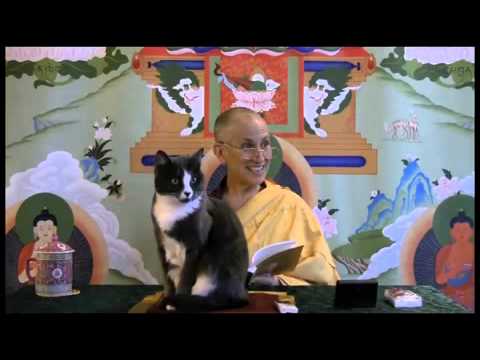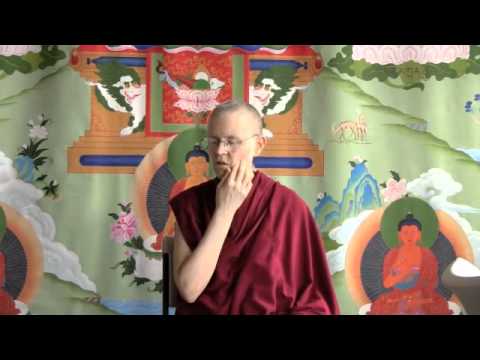Bodhicitta
Part of a series of teachings given at the Winter Retreat from December 2011 to March 2012 at Sravasti Abbey.
- Review of the three reasons to take refuge
- The power of reciting mantra for each and every sentient being
Vajrasattva 09: Bodhicitta (download)
The other day I was talking about taking refuge and generating the altruistic intention. I focused on the refuge part and today I’m going to focus mainly on the bodhicitta part.
In brief review, there are three reasons why we go for refuge, and, to make it a Mahayana refuge, I’ll talk about that third reason as well. The first reason is that we’re afraid of what’s coming up. Not just in this life, but in cyclic existence the potential plunge into lower realms. That gets me. I don’t know if it gets, you but it gets me. The second reason we go for refuge is we have faith in the Three Jewels. To cultivate that faith we really look at the qualities of the Three Jewels. The third reason is this sense of compassion to benefit everybody. This is what makes the refuge a Mahayana refuge.
Thinking back on my experience doing this Vajrasattva retreat, I would say the refuge words and the generating altruistic intention words. Then I would just think, “Okay, that’s done. I’m going to the purification part.” I really had a lot of regret that was really heartfelt. I would spend most of my time on that part of the practice, and it brought fruit for sure. At a certain point I got sick of my own stories. It was sort of like to the point of gagging. Fortunately I came across some other resources that helped me. I didn’t have the option that you’re having right now of hearing talks three times a week on the practice.
My best friend on this retreat, in addition to Venerable Chodron’s lamrim outline, was Lama Zopa’s book Teachings from the Vajrasattva Retreat. This one is quite daunting in size, but by the end of the retreat there were so many page markers stuck in here I couldn’t close the book. It was very valuable. Then the other book, which I would take on an island if I was left there, is Geshe Tegchok’s book Transforming Adversity into Joy and Courage.
I would like to share Lama Zopa’s book with you. It falls open at this part—actually the binding is broken here—and had I read these words at the beginning of the retreat I would not have understood it. I had to go through my own junk. I’d get somewhere and have a sense that I was bringing peace to these issues that were driving me nuts, and haunting me, and causing me great misery. Finally one day, probably it was six weeks into retreat, I encountered this section by Lama Zopa Rinpoche. The book is really broken here as you can see because I kept reading it over and over again. I think the day I found this I wanted to exclaim loudly, “Yes!” but we were in silence, so inside I went.
I’d like to read to you some of it. Up until this point the image that comes to mind is that my practice was like a garden hose with a big kink at the end of it. There was this little tiny dribble coming out of the nozzle. Then when I read these pages and started doing what Lama Zopa suggested, it was like someone said, “Hey, you know you’re stuck over there.” Then it was sort of like “psheeeew” and there was this big stream.
First of all he said (and this is what Venerable Chodron advised us to do) is to look at Shantideva’s text and see the benefits of bodhicitta. Lama Zopa quotes this:
How can one measure the merits one collects by generating the precious thought that is the cause of all happiness of all transmigratory beings and the medicine that cures the suffering of all sentient beings.
Bodhicitta. So that got my attention. But then what really got me going is this section where he says:
Now, when you do the Vajrasattva sadhana or other practices, even though they begin with the bodhicitta motivation, when you come to the mantra recitation, again, just before you begin to recite the mantra as I’ve already mentioned it a few times during some of the sessions, dedicate very precisely by thinking, “each mantra I recite is for every hell being, each mantra is for every hungry ghost, each mantra is for every animal, each mantra is for every human, each mantra is for every sura, asura, intermediate state being,” and so on.
That just lit my mind on fire. Now I could use my obsession with the mantra and use it to benefit just not piddly old me, this one puny me—but I could bring in all sentient beings. I just can’t tell you how happy I was the day I read that. It really transformed every single practice. Then I went on and included beings in this realm like people in hospital, people with HIV, people with every name of disease that you’re familiar with, people who are lonely, elderly people, abused. You name it, you can cover the gamut.
At a certain point when you go back and back and back in your life, hit the age of two, then what are you doing wrong? It’s just ignorance at that point. And then it’s like previous lives—well, I’ll speak for myself. I can’t remember my previous lives right now. But thinking like this I see that I’ve been in every realm multiple times. So I felt like not only was I doing this just for piddly old me but for all beings. That gave my practice some juice. I’m very happy to share that with you. You probably know this already but it just makes me happy every time I think about it.
Then of course the mind gets cranky some days and not even that works. The other day Venerable Chodron was jokingly saying we need to have someone develop a pill. Well, that would be good but I think the pill is bodhicitta. But the problem is it’s a tough pill to swallow because what it demands of us is responsibility.
In this same book on page 600, Lama Zopa started giving reasons to cultivate bodhicitta. Our minds just get cranky, or my mind gets cranky. So he tells the story of seeing someone who is very old and obviously visually impaired and they’re at the edge of a cliff. I can see that if they continue walking another five steps they will step right off the cliff and plunge to their death. Any one of us in the room (if you doubt that you have bodhicitta) would immediately spring up, if your body allowed it, and race to that person and grab them and save them from this terrible death. He says that’s what all beings are like who haven’t met the Dharma. Probably that’s what I’m still like in some moments even having met the Dharma. He said we have this potential, we have this human precious potential. We’ve met the Dharma. We have these precious teachers. We have some knowledge and we can help people. It’s our responsibility now that we’ve met the Dharma to develop ourselves to our best ability in every lifetime so that we can help all sentient beings—who are like the person with visual impairments just about to plunge and go off the cliff. That’s a very compelling reason to help us on those cranky days.
In summary, we can look at it like this. We all agree that we all want happiness. We want to be happy. We do not want suffering. And we do want meaning in our life for sure. The pill is bodhicitta. That’s the pill. We have to take the pill, and then we have to assume responsibility for that.
One last thing, someone asked me, “What does the grain of rice mean?” What this means for our retreat is that we should start off gracefully and gradually; and that if we do this we gain momentum so that we’re at the full speed of our retreat sort of halfway through; and then we sort of start tapering down as we reach the end of retreat. We want to sort of taper off so we can start to integrate ourselves into whatever life we live.
Venerable Thubten Samten
Venerable Samten met Venerable Chodron in 1996 when the future Venerable Chonyi took the future Ven. Samten to a Dharma talk at Dharma Friendship Foundation. The talk on the kindness of others and the way it was presented is deeply etched in her mind. Four Cloud Mountain retreats with Ven. Chodron, eight months in India and Nepal studying the Dharma, one month of offering service at Sravasti Abbey, and a two month retreat at Sravasti Abbey in 2008, fueled the fire to ordain. This took place August 26, 2010 (see photos). This was followed by full ordination in Taiwan in March, 2012 (see photos), becoming Sravasti Abbey's sixth bhikshuni. Right after finishing a Bachelor of Music degree, Ven. Samten moved to Edmonton to pursue training as a corporeal mime artist. Five years later, a return to university to obtain Bachelor of Education degree opened the door to teaching for the Edmonton Public School board as a music teacher. Concurrently, Ven. Samten became a founding member and performer with Kita No Taiko, Alberta's first Japanese drum group. Ven. Samten is responsible for thanking donors who make offerings online; assisting Venerable Tarpa with developing and facilitating the SAFE online learning courses; assisting with the forest thinning project; tracking down knapweed; maintaining the Abbey database and answering email questions; and photographing the amazing moments that are constantly happening at the Abbey.


